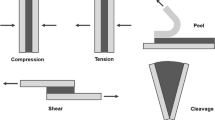Conclusions
-
1.
The rate of moisture absorption depends on the volume content of organic plastic in hybrid CM, and it increases with increasing content. Hybrid composites with distributed layers of organic plastic have greater moisture absorption than composites with “block” reinforcement with equal content of SVM.
-
2.
Thermohumid aging leads to impaired elastic and strength characteristics of organic carbon plastics, mainly on account of the sensitivity of the organic layers to these factors.
-
3.
When hybrid CM are exposed to high temperatures and moisture, there are reversible effects (change of the vitrification temperature) as well as irreversible effects (incomplete restoration of mechanical characteristics in uniaxial quasistatic tension and in three-point bending).
Similar content being viewed by others
Literature cited
K. K. Aniskevich, A. K. Kurzemnieks, and Yu. O. Yanson, “Investigation of the effect of long-term action of temperature and moisture on the elastic properties and structure of organic fiber plastic,” Mekh. Kompozitn. Mater., No. 4, 620–623 (1985).
A. K. Kurzemnieks, “Effect of moisture on the structure and properties of organic fiber,” Mekh. Kompozitn. Mater., No. 5, 919–922 (1980).
W. W. Wright, “The effect of diffusion of water into epoxy resins and their carbon-fibre reinforced composites,” Composites, July, 201–205 (1981).
Om. K. Joshi, “The effect of moisture on the shear properties of carbon fibre composites,” Composites,14, No. 3, 196–200 (1983).
The application of composite materials in products of foreign aviation technique, Part 1, in: Reviews of Materials of the Overt Foreign Press for 1969–1980, No. 644, TsAGI (1984), pp. 38–66.
M. E. Roulance and W. W. Houghton, “Effect of moisture on static and fatigue behavior of aramid composites,” J. Am. Helicopt. Soc.,28, No. 4, 3–13 (1983).
V. F. Mazzio and G. Huber, “Effect of temperature, moisture and radiation exposures on composite mechanical properties,” SAMPE J.,20, No. 2, 14–23 (1984).
P. E. Allred, “The effect of temperature and moisture content on the flexural response of kevlar/epoxy laminates: Pt. 1,” J. Composite Materials,15, 100–116 (1981).
P. E. Allred, “The effect of temperature and moisture content on the flexural response of kevlar/epoxy laminates: Pt. 2,” J. Composite Mater.,15, March, 117–132 (1981).
O. V. Startsev, V. P. Meletov, B. V. Perov, and G. V. Mashinskaya, “Investigation of the mechanism of aging of organic textolite in subtropical climate,” Mekh. Kompozitn. Mater., No. 3, 462–467 (1986).
K. K. Aniskevich, U. É. Krauya, and Yu. O. Yanson, “The effect of thermal and humid aging on the strain properties and the nature of failure of organic fiber plastic,” Mekh. Kompozitn. Mater., No. 2, 338–342 (1986).
V. N. Bulmanis, N. S. Popov, T. A. Starzhenetskaya, S. A. Kuz'min, G. I. Milyutin, and V. I. Polyakov, “The effect of completely reversed heat cycling and of moisture on the strength of wound glass fiber and organic fiber plastics,” Mekh. Kompozitn. Mater., No. 6, 1045–1051 (1988).
G. I. Milyutin, V. N. Bulmanis, G. S. Grakova, N. S. Popov, and A. M. Zakrzhevskii, “Investigation and prediction of the strength characteristics of epoxy wound organic fiber plastic in different regimes of environmental effects,” Mekh. Kompozitn. Mater., No. 2, 247–253 (1989).
Yu. V. Moiseev and G. E. Zaikov, The Chemical Stability of Polymers in Aggressive Media [in Russian], Moscow (1979).
S. L. Garanina, G. S. Shul', L. B. Lebedev, L. M. Shkirkova, L. A. Shchukina, M. A. Ermolaeva, and G. P. Mashinskaya, “The effect of water on the properties of organic fiber plastics,” Mekh. Kompozit. Mater., No. 4, 652–656 (1984).
M. N. Stepnov, Statistical Methods of Processing the Results of Mechanical Tests [in Russian], Moscow (1985).
C. Lina, La mesure des proprietes dynamiques des materiaux viscoelastiques a l'aide du viscoelasticimetre, in: Le rapport de “Metravib” (Ecully Ce'dex France), April (1983), pp. 65–79.
Author information
Authors and Affiliations
Additional information
Translated from Mekhanika Kompozitnykh Materialov, No. 2, pp. 279–285, March–April, 1990.
Rights and permissions
About this article
Cite this article
Kruzhkova, E.Y., Perov, Y.Y., Lokshin, V.A. et al. Properties of epoxy organic carbon plastics under conditions of thermohumid aging. Mech Compos Mater 26, 225–231 (1990). https://doi.org/10.1007/BF00612324
Received:
Revised:
Issue Date:
DOI: https://doi.org/10.1007/BF00612324




